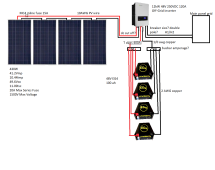Hi all,
I need some help with choosing the breakers and dc cut off switch and bus bars.
So far I’ve purchased the Growatt 12k inverter, 4 EG4 48volt 100ah batteries. 400 amp t class fuse. 15 amp inline mc4 fuse. 1/0 awg wire. 2 awg wire and PV wire.
2awg wire will run from the batteries to bus bars(parallel). Wires will be same length.
1/0 positive from bus bar to t class fuse to inverter. Negative from bus bar to inverter. Is DC breaker needed between batteries and inverter?
For this setup will 300amp bus bar be enough or higher?
AC and DC breakers amp size? Double pole breaker? Growatt 12k max PV input 2x 3500 watts = 7000w
and a DC cut off switch amperage/wattage size?
Will be connecting to the grid (240v) to recharge the batteries. Solar will be only be 4 or 6 panels for now, due to lack of space.
Please share any advice, tips or concerns. Thanks for all the help.
I need some help with choosing the breakers and dc cut off switch and bus bars.
So far I’ve purchased the Growatt 12k inverter, 4 EG4 48volt 100ah batteries. 400 amp t class fuse. 15 amp inline mc4 fuse. 1/0 awg wire. 2 awg wire and PV wire.
2awg wire will run from the batteries to bus bars(parallel). Wires will be same length.
1/0 positive from bus bar to t class fuse to inverter. Negative from bus bar to inverter. Is DC breaker needed between batteries and inverter?
For this setup will 300amp bus bar be enough or higher?
AC and DC breakers amp size? Double pole breaker? Growatt 12k max PV input 2x 3500 watts = 7000w
and a DC cut off switch amperage/wattage size?
Will be connecting to the grid (240v) to recharge the batteries. Solar will be only be 4 or 6 panels for now, due to lack of space.
Please share any advice, tips or concerns. Thanks for all the help.



